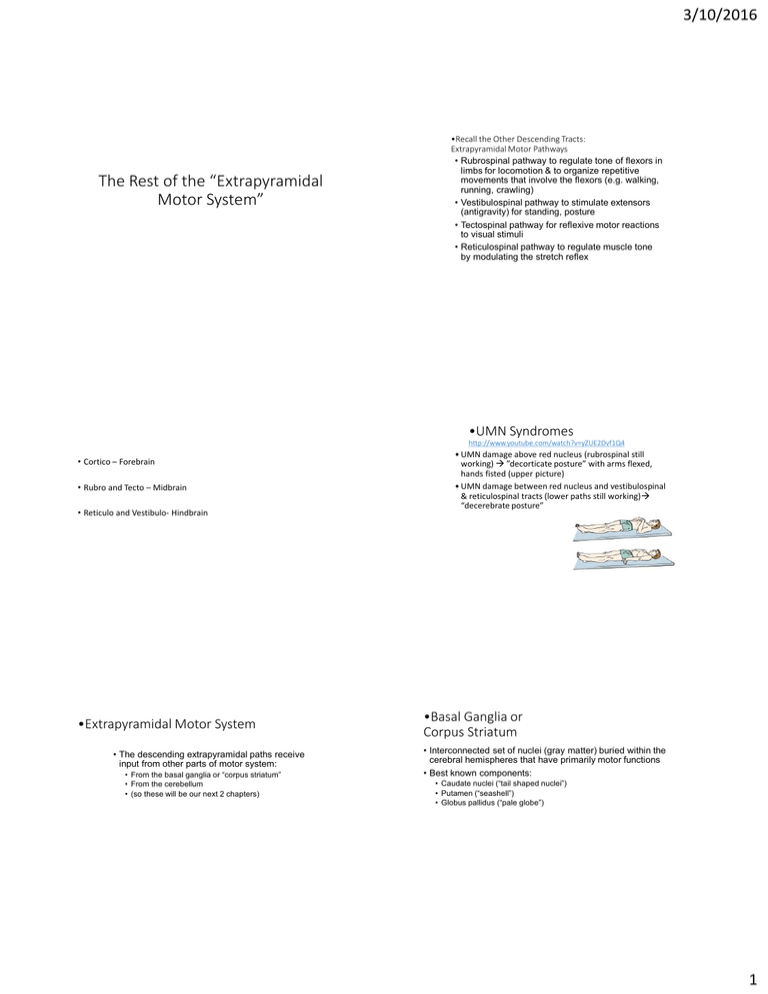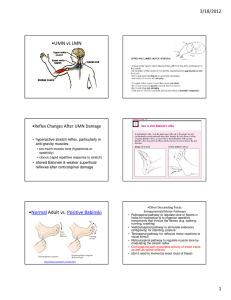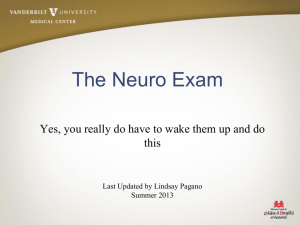3/10/2016
advertisement

3/10/2016 The Rest of the “Extrapyramidal Motor System” •Recall the Other Descending Tracts: Extrapyramidal Motor Pathways • Rubrospinal pathway to regulate tone of flexors in limbs for locomotion & to organize repetitive movements that involve the flexors (e.g. walking, running, crawling) • Vestibulospinal pathway to stimulate extensors (antigravity) for standing, posture • Tectospinal pathway for reflexive motor reactions to visual stimuli • Reticulospinal pathway to regulate muscle tone by modulating the stretch reflex •UMN Syndromes http://www.youtube.com/watch?v=yZUE2Dvf1Q4 • Cortico – Forebrain • Rubro and Tecto – Midbrain • Reticulo and Vestibulo- Hindbrain •Extrapyramidal Motor System • The descending extrapyramidal paths receive input from other parts of motor system: • From the basal ganglia or “corpus striatum” • From the cerebellum • (so these will be our next 2 chapters) • UMN damage above red nucleus (rubrospinal still working) ”decorticate posture” with arms flexed, hands fisted (upper picture) • UMN damage between red nucleus and vestibulospinal & reticulospinal tracts (lower paths still working) “decerebrate posture” •Basal Ganglia or Corpus Striatum • Interconnected set of nuclei (gray matter) buried within the cerebral hemispheres that have primarily motor functions • Best known components: • Caudate nuclei (“tail shaped nuclei”) • Putamen (“seashell”) • Globus pallidus (“pale globe”) 1 3/10/2016 •Basal Ganglia or “Striatum” • Caudate & putamen get input from cortex, thalamus & substantia nigra, a midbrain motor area • They send commands to globus pallidus which sends them on to the motor portions of thalamus & brainstem • Very interconnected system with lots of feedback loops 2 3/10/2016 •Functions • The basal ganglia are important for: • Facilitating or initiating motor programs – often multiple programs at once (via what is known as its “direct pathway”) • Inhibiting undesired movements; terminating voluntary movements (via what is known as its “indirect pathway”) • We might think of the BG serving as both the gas pedal and the brake pedal for the activity of the motor cortex •Parkinson’s Disease (paralysis agitans or shaking palsy) • About 1% of those over 50 have PD (~ 1,000,000 total in US; 60,000 new cases/yr; 90% cases occur after age 60) • Progressive deterioration of DA input to basal ganglia- the “nigrostriatal pathway” from substantia nigra in midbrain to the “striatum”in forebrain • We lose about 4% of those DA neurons/decade, but those with PD have accelerated loss (70% or more gone) • Results in difficulty initiating movements & tremor PD vs normal SN Normal # of DA cells vs PD 3 3/10/2016 •Classic PD Symptoms • The nigrostriatal path sends DA messages from the substantia nigra to the basal ganglia. •Possible Causes • Environmental toxin of some sort (industrial heavy metals, pesticides, “free radicals” currently under study) • http://www.youtube.com/watch?v=oW33gBl3yvs&context=C 3c0a567ADOEgsToPDskL0gMaiaYEJ97F_Ity38QqR (go to 9 min) • Genetics (strong link in early-onset PD; weak link in regular PD) • Brain trauma may increase your risk Treatments • Increase DA production with l-dopa • Worsening bradykinesia (slowing of movement) & akinesia (loss of movement) • Rigidity (too much muscle tone); clumsiness, decreased postural stability so tends to fall • “Pill-rolling” tremor-at-rest • Reduction in movement is also seen in lack of facial expression & blinking; shuffling walk without assoc. arm movements; soft, halting, monotone voice; slow blinks; small writing; feeling stuck or frozen PD Concordance in Twins • Late-Onset (161 pairs studied) • MZ 13% • DZ 16% • Early Onset (16 pairs) • MZ 100% (4 pairs) • DZ 16% As PD progresses ON’s get shorter & upping dose increases side effects • Problems: l-dopa induced dyskinesia side effects & loss of effectiveness over time http://www.youtube.com/watch?v=2TU2s3VxEI4 • Prevent DA breakdown or reuptake • E.g. Eldepryl (selegeline); Azilect(rasagiline) • Stimulate DA receptors with DA agonist • Parlodel (bromocriptine); Mirapex (pramipexole), Requip (ropinirole) 4 3/10/2016 •When Drug Therapy Fails • When drug effectiveness declines, experimental options include: • Deep brain stimulation to block hyperactivity in this system • http://www.youtube.com/watch?v=abHuHFt_izI • http://www.youtube.com/watch?v=xzxsspsgZG4 • DBS has pretty much replaced earlier surgical treatments like pallidotomy ; thalamotomy (Michael J. Fox • Experimental: Transplant of DA producing cells into brain •Functions • The basal ganglia are important for: • Facilitating or initiating motor programs – often multiple programs at once (via what is known as its “direct pathway”) • Inhibiting undesired movements; terminating voluntary movements (via what is known as its “indirect pathway”) • We might think of the BG serving as both the gas pedal and the brake pedal for the activity of the motor cortex •Tourette Syndrome • 40% report “sensory tics” – uncomfortable sensations that may be a reason for some of the involuntary movements • Some degree of suppressibility, but individual experiences increased tension until tic is released • Pattern of tics changes & waxes & wanes with changes in stress, anxiety, fatigue. • Treated with DA blockers (Haldol, Orap). Milder tics may respond to NE agonist clonidine. • Majority experience decreased tics as adults. • In a small % of kids symptoms are aggravated or first appear after a strep infection (“PANDAS”) • https://www.youtube.com/watch?v=HrIZDnnMPaI •Parkinson’s Disease Update • Although PD is thought of as a motor disorder, the decline in DA also produces cognitive and emotional changes in some • depression • “bradyphrenia” (cognitive slowing); decreased attention • “frontal lobe” symptoms (disinhibition of behavior, poor judgment and planning) • Full-blown dementia in ~40-50% (associated with neuropathological sign called Lewy bodies) • PD treatment, on the other hand, can produce hallucinations and other symptoms of psychosis •Tourette Syndrome • A usually hereditary BG disorder characterized by involuntary movements • Multiple motor tics - simple tics of face or limbs and/or more organized complex tics (touching, grimacing, pinching, poking, adjusting, hitting, jumping, kissing, throwing, gestures) plus: • Phonic or vocal tics - both simple (throat-clearing, coughing, hiccuping, grunting, yelping) and/or complex tics (actual words, coprolalia, echolalia, palilalia, assuming different voices, talking to oneself in different voices) • Seems to affect frontal lobe- BG connection that is important for our ability to inhibit actions •Link with Other Disorders • ~50-60% also suffer OCD (others estimate that up to 90% experience some involuntary touching compulsions, ritualistic behaviors, intrusive thoughts) • ~50-90% show evidence of ADHD as well; first signs of GTS are usually impulsive, hyperactive behaviors (before tics appear) • About 30% have learning disabilities, emotional lability, rage, aggressiveness; 40-50% depressed • Initially suspected a single gene with sex-linked, varied forms of expression of disinhibition, but now appears more genetically complicated • 50-73% concordance in identical twins vs 8-22% in fraternal twins 5 3/10/2016 •Impairment of the Inhibitory Functions of the BG • Dyskinesias – involuntary movements • Chorea (“dance-like”) – quicker irregular movements • Athetosis – slower writhing, twisting movements • Dystonias – abnormalities of excessive muscle tone; muscle spasms • Can also have much more complex involuntary movements Ventricles enlarged, caudate & other BG reduced in size •Huntington’s Disease • Transmitted by a dominant gene on chromosome 4 (about 30,000 US cases with 150,000 at risk kids) • Deterioration of striatum produces involuntary chorea, athetosis & other motor difficulties • Cortical deterioration causes progressive & debilitating dementia, aggressiveness, mood swings, depression, psychosis • Death due to health complications in 15-20 yrs •Huntington’s Disease • Bad gene has excess “CAG repeats” (more than 36250 instead of usual 29 or fewer) resulting in an abnormal form of protein known as huntingtin. • The more repeats, the earlier symptoms appear. • # of repeats can increase across generations, especially in kids inheriting gene from father • Brain damage may be due to decrease in normal protective huntingtin + adverse effects of abnormal protein on critical growth factors keeping cells alive. • HD may cause increased susceptibility to excitotoxic glutamate and/or abnormal programmed cell death.. •CAG Repeats & Age of Symptom Onset # of CAG repeats in a father & 6 sons & age of first symptoms •Treatments for HD • Genetic testing to identify presence of the gene • Involuntary movements may be decreased by DA blockers (antipsychotics) • New drugs being tried to delay progression: • Rilutek (riluzole), Neurontin (gabapentin) decrease glutamate transmission • Rapamycin (transplant drug) speeds elimination of abnormal protein • Growth factor supplementation being studied • Experimentation with brain cell transplants/surgeries is underway 6 3/10/2016 •The Cerebellum •Anatomy of the Cerebellum • 2 hemispheres with vermis in between • Very folded cerebellar cortex • Underlying white matter & deep nuclei • Deep nuclei are the output pathway • Massive cerebellar peduncles (axon bundles to and from cerebellum) connecting to brainstem 7 3/10/2016 •Evolution of Cerebellum • Oldest part is the flocculonodular lobe - it gets input from the vestibular system (Vestibulocerebellar path) • Next: the region around the vermis gets proprioceptive & cutaneous input via spinal cord (spinocerebellar tr.) • Most recent region – the hemispheres- get input from cortex via the pons (corticopontocerebellar path) • All input goes to cerebellar cortex; all output is from the deep cerebellar nuclei • Loop-like feedback to each of those sources of input •Mode of Functioning • Totally unconscious • Computer-like feedback loops • Moment-to-moment adjustments • Ipsilateral in its control (right side of cerebellum related to movements of right side of body) Primitive Frog Cerebellum in Blue •Cerebellum Is Needed For: • Fluid coordination of movements • Synergy/cooperation between muscles • Precise timing & targeting of movements • Appropriate force & muscle tone • Refining & storing these details during motor learning • Automatic adjustments to changing conditions & to maintain balance 8 3/10/2016 Symptoms of Cerebellar Damage • Gait ataxia – wide-based, staggering walk, may shuffle,veer to side, may fall http://www.youtube.com/watch?v=5Dj827uCP3g •Test for Dysdiadochokinesia • http://www.youtube.com/watch?v=5eBwn22Bnio • Disturbed balance (can’t balance on 1 foot; walk heel-to-toe) • Poor muscle tone (hypotonia) • Adiadochokinesia/Dysdiadochokinesia - can’t rapidly alternate movements http://www.neuroexam.com/36.html 2 • Nystagmus-jerky, oscillating eye movements (see dbnystag. clip) http://www.youtube.com/watch?v=oUlUVWQx7zI • Midline lesion most likely to cause gait, posture, balance problems - Romberg test http://www.neuroexam.com/neuroexam/content.php?p=37 •Symptoms • Dysmetria - poor targeting of movement; over- or under-reach http://www.youtube.com/watch?v=TQQtd7b-LE4 • Can’t do finger to nose test • Intention tremor while targeting movements (see clip) • Asynergia - loss of fluid coordination & cooperation between muscles; movements jerky & disjointed • 3 year old with cerebellar symptoms • http://www.youtube.com/watch?v=jx9Eq6Jxg9s • Dysarthria/Dysphonia - slurred, uncoordinated speech & speech volume • Lateral lesion- affects ipsilateral limbs • http://www.youtube.com/watch?v=5eBwn22 Bnio Causes of Cerebellar Damage • Strokes or tumors affecting cerebellum • Demyelination due to MS • Genetically based degenerative disorders (e.g. Friedrich’s ataxia caused by degeneration of spinocerebellar tracts) • Alcoholic cerebellar atrophy. Cerebellum can also be damaged by some anticonvulsants or chemotherapy. • Tumor •Medulloblastoma • A cerebellar tumor usually originating in the vermis, which then presses down on the brainstem • Accounts for ~1 in 20 brain tumors (1 in 5 in kids). 2/3 cases occur before age of 15 (median age = 5-6) • Symptoms: Falling, nausea & vomiting, double vision, headache, eventually trouble moving. If its located on midline child will tend to fall forward or backward 9 3/10/2016 10





